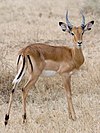The impala (Aepyceros melampus) is a medium-sized antelope in eastern and southern Africa. First described by German zoologist Hinrich Lichtenstein in 1812, it reaches 70–92 centimetres (28–36 inches) at the shoulder, weighs 40–76 kilograms (88–168 pounds), and has a glossy, reddish brown coat. The male's slender, lyre-shaped horns can reach 45–92 centimetres (18–36 in), measured along the curve. Active mainly during the day, the impala may be gregarious or territorial. Three distinct social groups can be observed – the territorial males, bachelor herds and female herds. Browsers as well as grazers, impala feed on monocots, dicots, forbs, fruits and acacia pods. An annual, three-week-long rut takes place toward the end of the wet season, typically in May, and gestation lasts six to seven months. Calves are suckled for four to six months. The impala is found close to water, in woodlands and sometimes at the interface between woodlands and savannahs. The common impala is widespread across its range and has been reintroduced in Gabon and southern Africa, but the black-faced subspecies has been classified as a vulnerable species. (Full article...)
from Wikipedia featured articles feed http://ift.tt/2jRZcwk







0 commentaires:
Enregistrer un commentaire